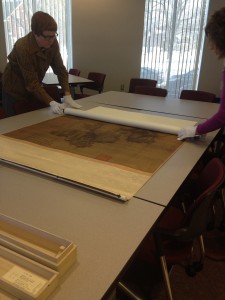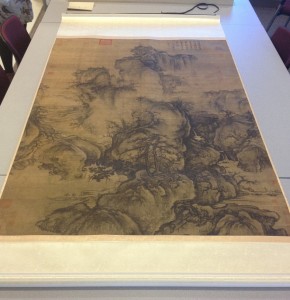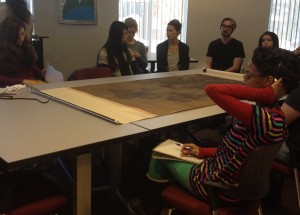 Early Spring, a masterpiece painted by Kuo Hsi in the year 1072, stands as a lasting testament to the infinite beauty of pressure and ink on silk. The scroll painting, originally painted as two, depicts a mist and tree-covered mountain and is produced in a style that Kuo Hsi developed after studying the work of Chinese master Li Ch’eng. Kuo Hsi held a high position in the Imperial Painting Academy and wrote a treatise on landscape painting. Through the diligent work of his son, Kuo Ssu, Kuo Hsi’s work was consolidated into a family collection which, though seldom seen by individuals outside the family, was preserved and treasured.
Early Spring, a masterpiece painted by Kuo Hsi in the year 1072, stands as a lasting testament to the infinite beauty of pressure and ink on silk. The scroll painting, originally painted as two, depicts a mist and tree-covered mountain and is produced in a style that Kuo Hsi developed after studying the work of Chinese master Li Ch’eng. Kuo Hsi held a high position in the Imperial Painting Academy and wrote a treatise on landscape painting. Through the diligent work of his son, Kuo Ssu, Kuo Hsi’s work was consolidated into a family collection which, though seldom seen by individuals outside the family, was preserved and treasured.
As Chiang Chao-shen notes in an introduction to the scroll,
The silhouette of the rocks and boulders is delineated with a heavy touch, the fog-washed trees with a light one. The washes work in harmony to express a complete idea of nature’s forms under these seasonal conditions – with the treetops disappearing imperceptively into the vapor, their trunks still vigorously etched in darker ink.
The original scroll is housed in the National Palace Museum, Taipei, Republic of China. The fine art facsimile held at the Dodd Research Center, made by Nigensha Publishing  Company of Japan, was on view for students in Dr. Yan Geng’s East Asian Painting class on Wednesday, February 18. It will be unrolled again on Monday, February 23, 2015. The piece was acquired specifically for use in the classroom.
Company of Japan, was on view for students in Dr. Yan Geng’s East Asian Painting class on Wednesday, February 18. It will be unrolled again on Monday, February 23, 2015. The piece was acquired specifically for use in the classroom.
Archives in Action highlights how archives are being used today. Series author Lauren Silverio is an English and Psychology major and student employee in Archives and Special Collections.
